The earliest railways in Llanelli were opened by the Llanelly Railway and Dock Company in 1834, mainly due to the needs of the coal industry, and over the coming years branch lines were extended to serve the Amman Valley and Llandeilo. As the years passed by lines opened to link Llanelli to all of its neighbouring towns and by 1873 the Great Western Railway had taken over the lines and work was underway to improve them. Many men who worked for the GWR at Llanelli volunteered to serve their country during the Great War, thirteen of whom died.
The Great War, 1914-1918
Harry Montague Allen, Private, 20965, Welsh Regiment. Harry was born in Prendergast, Haverfordwest, on 23 April 1896, the eldest son of Thomas and Edith Allen. The family later resided at 3, Glendale Terrace, Whitland. Thomas joined the Great Western Railway and became a Carpenter at the Llanelli Locomotive and Carriage Department. At the outbreak of War, He enlisted at Llanelli into the 15th Battalion, Welsh Regiment, which was known as the Carmarthen Pals Battalion. After training at Rhyl and Winchester, the battalion moved to France from 2 December 1915 attached to 114 Brigade, 38th (Welsh) Division. During the coming months the Battalion held nearly every section of the British line from Givenchy on the La Bassée Canal to Laventie, about six miles South of Armentières. At the end of May 1916, the Battalion moved South with the remainder of the 38th (Welsh) Division to the Somme area, in readiness for the First Battle of The Somme, which commenced on 1 July 1916. The 38th Division was tasked with the taking of the infamous Mametz Wood, and the Division made its first assault on 7 July 1916, suffering terrible casualties. After the sacking of their Commander, Sir Ivor Philipps, the Division made a renewed assault on 10 July 1915, and the Carmarthen Pals were thrown into action, and plunged into terrible fighting at the ‘Hammerhead’. The wood was cleared with two days of terrible hand to hand fighting, but at the cost of over 5,000 casualties in the 38th (Welsh) Division. It was during the first attacks on the wood that Harry was shot in the chest by a German sniper, and brought back by rail to the 38th Casualty Clearing Station at Heilly, in the Somme valley. Harry died of his wounds on 11 July 1916, and is buried in Heilly Station Cemetery, France.
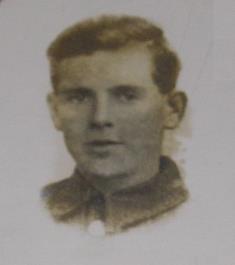
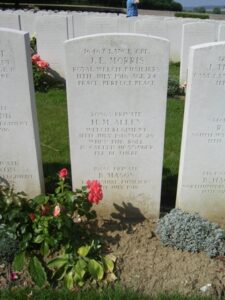
William Charles Carter, Private, 8139, Royal Berkshire Regiment. William was born in Abingdon, Berkshire on 15 August 1888, the son of William and Lizzie Carter. He had served for several years with the Royal Berkshire Regiment before moving to Llanelly with his wife Mary after gaining a role as a Locomotive Boiler Smith’s Mate at the Llanelli GWR Locomotive and Carriage Department on 17 February 1914. Following the outbreak of war he re-joined his old battalion, the 1st Battalion, Royal Berkshire Regiment, which was attached to 99 Brigade, 2nd Division. He landed in France on 20 September 1914, joining the battalion following its withdrawal from Mons to the Marne and moved with the battalion to Ypres. William saw heavy fighting with his battalion during the First and Second Battles of Ypres and in September 1915 took part in the Battle of Loos, remaining in the area over the winter. William was killed during a patrol near Le Quesnoy, in a section called Deadman’s Trench, on 6 February 1916. He was 36 years old, and is buried in Chocques Military Cemetery, France.
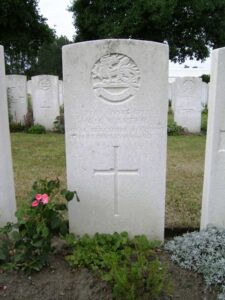
Arthur Corbett, Private, 9668, Wiltshire Regiment. Arthur was born on 22 September 1894, the son of Henry and Marian Corbett, of 8, Albion Street, Swindon, Wilts. He was an army reservist and worked as a Locomotive Fireman at the Great Western Railway Locomotive and Carriage Department at Llanelli prior to the war. He returned home to re-enlist into the 2nd Battalion, Wiltshire Regiment. The battalion was attached to 21 Brigade, 7th Division, and on 7 October 1914 landed at Zeebrugge, before moving to positions east of Ypres. After helping stop the German drive towards the Channel Coast at Ypres, the Division moved south to Fleurbaix. It was here, during a routine spell of trench warfare on 23 February 1915, that Arthur was killed, possibly when a German aircraft dropped a bomb which exploded near the battalion HQ. He was 20 years old, and is buried in Rue-David Military Cemetery, Fleurbaix, France.
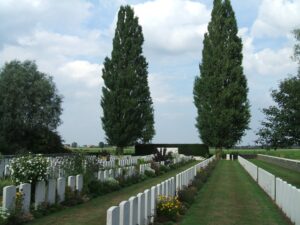
Robert Henry Davies, Private, 62306, Welsh Regiment. Robert was the son of James and Elizabeth Davies of Westbourne Cottage, Tenby. He worked as a Porter with the G.W.R. at Llanelli prior to the war, and resided at Tyasha Road, Llanelli. Robert enlisted at Llanelli into the Welsh Regiment on 13 December 1915, and was posted to France on 15 March 1918, where he joined the 15th Battalion, Welsh Regiment, which was the Carmarthen Pals battalion. The battalion was attached to 114 Brigade, 38th (Welsh) Division, and Robert joined them at Armentieres. During April 1918 the Division moved to the Somme, and took up positions north of Albert, around Aveluy Wood. They remained here until launching their offensive across the River Ancre on 21 August 1918, which began their drive across the old battlefields towards the Hindenburg Line. When the Hindenburg Line had been broken, the Welshmen drove towards Le Cateau, and the Forest of Mormal. Robert was killed while the 15th Welsh were fighting around Pierre Mill on 8 October 1918. He was 25 years old, and is buried at Moulin-De-Pierre British Cemetery, France. He is not commemorated on the new GWR Memorial.
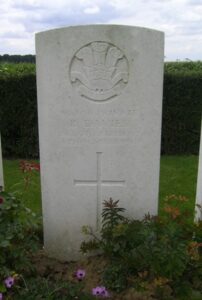
Robert Thomas Davies, Private, 24979, Grenadier Guards. Robert was born in Betchworth, Surrey in 1892, the son of Robert and Ann Bishop Davies. His father was from Pont Garrig, Llandyrnog, Denbighshire, who had travelled the country during his work as a domestic coachman. Prior to the outbreak of war, Robert was working as a Parcel’s Porter in the Traffic Department of the Great Western Railway Depot at Llanelli. He enlisted in London into the Grenadier Guards, and was posted to France in 1916, joining the 4th Battalion, Grenadier Guards, which was attached to 3rd Guards Brigade, Guards Division. In July 1916 the Division moved to the Somme and took part in the Battle of Flers-Courcelette, where tanks were used for the first time. During the last weeks of September 1916 the Guards Division was heavily involved in fighting during the Battle of Morval. Robert was wounded during this period and was evacuated by rail to No 1 South African General Hospital at Abbeville, where he died of his wounds on 22 October 1916, aged 24. He is buried in Abbeville Communal Cemetery Extension, France.
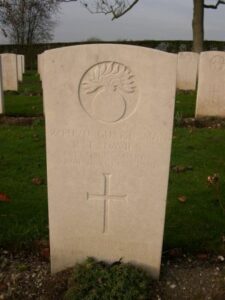
Ivor Monroe Griffiths, Private, 2252, Welsh Regiment. Ivor was born on 10 February 1896, the son of John and Hannah Griffiths, of Dryslwyn House, Parcmain Street, Carmarthen. He worked as a Locomotive Fireman at the Great Western Railway Locomotive and Carriage Department at Llanelli prior to the war, and enlisted at Carmarthen into the 1/4th Battalion, Welsh Regiment, which was the local Territorial Battalion, attached to 159 Brigade, 53rd (Welsh) Division. The Division landed at Cape Helles, Gallipoli, on 9 August 1915, and was immediately thrown into action, spending the next few days in isolated pockets, fighting against a Turkish counter-attack during the Battle of Sari Bair, and then at the Attack on Scimitar Hill. Ivor became ill with enteric fever, and was brought by Hospital Ship to Alexandria, where he died on 28 October 1915, aged 19. He is buried in Alexandria (Chatby) Military and War Memorial Cemetery, Egypt.
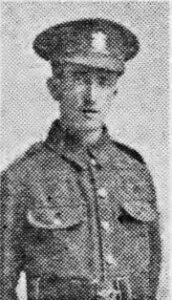
John Hall, Private, 4517, Gloucestershire Regiment. John was born on 29 September 1893, the son of Thomas and Elizabeth Hall, of Tanyard, Winchcombe. He worked as a Clerk in a Game Factory prior to coming to Llanelly on 2 September 1914 to work as a Fire Cleaner at the Great Western Railway Locomotive and Carriage Department and later became a Storesman. He enlisted in August 1915 into the Gloucestershire Regiment and was posted to D Company, 2nd/5th Battalion, Gloucestershire Regiment, which was attached to 184 Brigade, 61st (South Midland) Division. John landed in France with his battalion on 23 May 1916, just weeks after marrying Matilda Banks. John was killed in action during one of his first tours in the trenches near Riez Bailleul on 21 June 1916, aged 22. He is buried in Royal Irish Rifles Graveyard, Laventie, France.
William Henry Harries, Sapper, 45944, Royal Engineers. William was born at Neath in 1890, the son of David and Margaret Harries. He married Lizzie Morgan early in 1912, and the couple set up home at Aubrey House, Bethesda Road, Tumble, where their son Frederick Lewis Harries was born on 16 November 1912. William worked as a Fitter’s Labourer in the Locomotive and Carriage Department of the Great Western Railway at Llanelli. He enlisted at Tumble into the Royal Engineers. William landed in France on 11 September 1915, and served with the 97th Field Company, Royal Engineers, which was attached to the 21st Division. He saw service at Loos that month, on the Somme in 1917, then at Passchendaele in 1917. At some time, William became ill, and was evacuated to Britain for treatment for shell shock. Sadly, he died on 16 January 1918, aged 27, and is buried in Tumble (Bethania) Congregational Chapelyard.
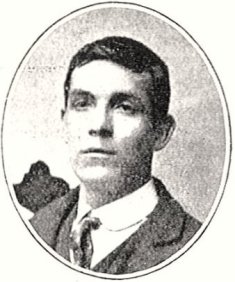
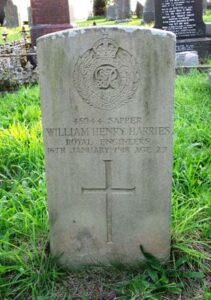
David Alfred Hodges, Z/2750, Ordinary Seaman, Royal Naval Reserve. David was born on 17 February 1896, the son of Thomas and Mary Hodges, of 41, Robinson Street, Llanelli. He worked as a Clerk in the Goods Office of the Great Western Railway at Llanelli prior to the war, and enlisted into the Royal Naval Reserve on 24 December 1915, training as a Wireless Operator. He was posted to Milford Haven, where he served as a Wireless Operator aboard HM Trawler Imelda, which had been requisitioned by the Admiralty for use as a minesweeper. David survived the war, but died of tuberculosis on 3 June 1919, aged 23. He is buried with his parents at Box Cemetery, Llanelli. Following my research, his details were passed to the CWGC on 6 February 2013, and he has finally been accepted for commemoration by them on Friday 5 July 2013, after almost 94 years of being forgotten. David will be temporarily commemorated on the UK Book of Remembrance at Maidenhead, Berkshire, until the location of his grave can be verified.
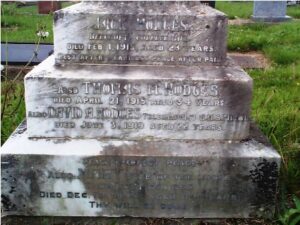
James James, Lance Corporal, 3876, Royal Warwickshire Regiment. James was the Grandson of Robert and Sarah James, of 20, High Street, Llanelli. In 1910 he began working as a Porter in the Goods Department of the Great Western Railway, at Llanelli. He had served with the 4th Welsh, before being transferred into the 2/7th Battalion, Royal Warwickshire Regiment, which was attached to 182 Brigade, 61st (2nd South Midland) Division. The Division landed in France on 21 May 1916, and moved to the Flanders sector, near Fromelles, where they took over the line held by the 38th Division. Here the Division was to take place in a combined attack with the 4th Australian Division, as a diversion to the main attack on the Somme, but it was a slaughter, with thousands of lives lost needlessly. James was killed just prior to this disastrous attack, on 30 June 1916. He was 20 years old, and is buried in Pont-Du-Hem Military Cemetery, La Gorgue, France.
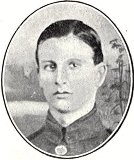
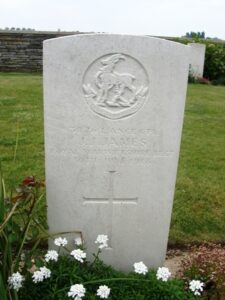
Thomas Henry James, Rifleman, A/186, Kings Royal Rifle Corps. Thomas was the son of John James, of Houghton Post Office, Neyland. He had worked as a Locomotive Engine Cleaner for the Great Western Railway at Llanelli before the war, and enlisted at Llanelli into the Army. He was posted to the 8th Battalion, Kings Royal Rifle Corps, which was attached to 41 Brigade, 14th (Light) Division. The Division was to see its first action during the Action of Hooge, where the Division were the first to be attacked by the German use of flamethrowers. It was probably during this action that Thomas was wounded. He died of wounds on 5 August 1915, but sadly his grave was lost during later fighting, and so he is commemorated on the Ypres (Menin Gate) Memorial, Belgium. He was just 20 years old.
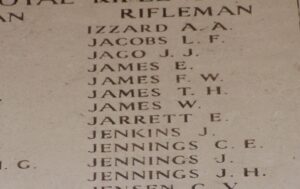
Harry Revell, Private, 16085, Devonshire Regiment. Harry was the son of William and Lydia Revell, of Newton Abbott, Devon. He worked as a Locomotive Fireman, with the Locomotive and Carriage Department of the Great Western Railway at Llanelli. He enlisted at Llanelli into the 9th (Service) Battalion, Devonshire Regiment, which was attached to 20 Brigade, 7th Division. The Division landed at Zeebrugge on 6 October 1914, but the City was falling, and the Division moved to Ypres, where they became the first British Division to hold the city. They fought during the First Battle of Ypres, and helped stop the German advance through Belgium, and in March 1915 fought at the Battle of Neuve Chapelle. During May they fought at the Battle of Aubers Ridge, and at Festubert, before taking part in the Battle of Loos in September. Harry was killed at Loos on 30 September 1915, aged 21. He is commemorated on the Loos Memorial, France.
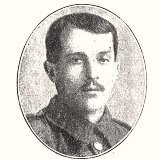
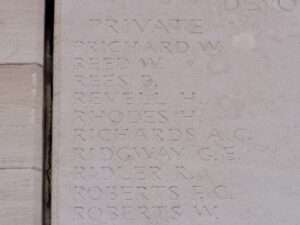
Edwin Isaac Thomas, Corporal, 200457, Welsh Regiment. Edwin was the son of John and Mary Thomas, of 52, Little Water Street, Carmarthen. He lived at 75, Priory Street, Carmarthen, with his wife and two young children. Edwin worked as a Time and Storekeeper in the Locomotive and Carriage Department of the Great Western Railway at Llanelli prior to the war. He enlisted into the army, and served as a sergeant-instructor in a signalling section for several months, prior to going to Egypt in February 1917, where he joined the 1/5th Battalion, Welsh Regiment. The battalion was attached to 159 Brigade, 53rd (Welsh) Division, and was preparing for the advance into Palestine. Edwin was killed in action during the Third Battle of Gaza, on 3 November 1917. He was 27 years old, and is buried in Beersheba War Cemetery, Israel.
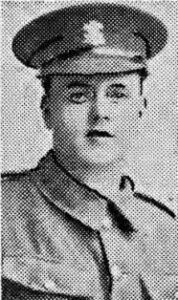
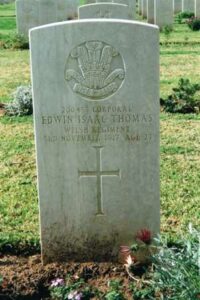
Sidney David Watkins, Private, 74251, Kings Liverpool Regiment. Sidney was born at Dudley on 21 January 1898, the son of David and Jane Watkins. By 1909 the family was residing at Penrallt Felyn, Cilgerran. Sidney began working at Llanelli as an engine cleaner for the GWR on 1 November 1915, but just eight months later was called up and enlisted at Cardiff into the army. He was posted to the 19th Battalion, King’s Liverpool Regiment, which was in France attached to 89 Brigade, 30th Division. The Division moved to France in November 1915, and took part in its first major action during the Somme Offensive, at the Battle of Albert, where they captured Montauban. They then fought during the latter stages of the offensive, during the Battle of Le Transloy, before wintering on the Somme. In March 1917 the Division followed the German Retreat to the Hindenburg Line, and in April took part in the First Battle of the Scarpe, and then at the later Second Battle of the Scarpe. Later that year they were moved north to Ypres, and fought at the Battle of Pilckem. Sidney must have been wounded in France, and was medically downgraded and attached to the 84th Company, Labour Corps, with his Service Number changing to 50245. Sidney was wounded whilst at Cambrai during early January 1918 and was evacuated to a Hospital near Boulogne where he died of wounds on 18 January 1918. Sidney was just 19 years old, and is buried at Wimereux Communal Cemetery, France. Sidney is not commemorated on the main GWR Memorial, and is not listed among the names of the fallen railwaymen listed by the National Railway Museum.
Walter Alan Williams, Private, 5241, Oxfordshire & Buckinghamshire Light Infantry. Walter was born in Hackney on 28 November 1895. By 1901 his father had died and he lived with his mother, Mrs Annie Keeler, and her husband Charles Stephen Keeler, at 29, Bath Street, St. Clements, Oxford. Walter originally worked for the Great Western Railway at Swindon, before becoming a Fireman in the Locomotive and Carriage Department of the Great Western Railway at Llanelli prior to the war. He enlisted at Oxford into the 1st/4th Battalion, Oxfordshire & Buckinghamshire Light Infantry, which was attached to the South Midland Brigade in South Midland Division. On 30 March 1915 the battalion landed at Boulogne and six weeks later the formation became 145 Brigade, 48th (South Midland) Division. Walter was killed in action on the Somme, during the Battle of Pozieres on 23 July 1916, aged 21. He is buried in Pozieres British Cemetery, Ovillers-La Boisselle, France.